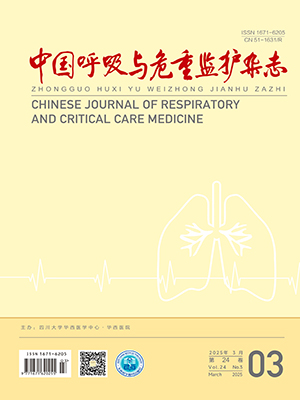Objective To investigate the value of extravascular lung water index ( EVLWI) and intrathoracic blood volume index ( ITBVI) monitoring in fluid management of severe pneumonia patients with sepsis shock.
Methods A prospective controlled study was conducted in106 patients who were diagnosed as severe pneumonia with sepsis shock in intensive care unit fromJanuary 2010 to February 2013. 54 patients who received pulse indicator continuous output ( PiCCO) monitoring were enrolled into the EVLWI + ITBVI group, and EVLWI and ITBVI were used as indicator of fluid management. 52 patients who received central venous pressure ( CVP) as indicator of traditional fluid managementwere enrolled into the control group. The time and the rate to achieve early goal-directed therapy ( EGDT) target were compared between two groups. Acute physiology and chronic health evaluation Ⅱ ( APACHE Ⅱ ) , sepsis related organ failure assessment ( SOFA) , noradrenaline dosage, serumlactic acid, serum creatinine were compared between 1 day and 3 days after treatment. The characteristics of fluid management were recorded and compared within 72 hours. Mechanical ventilation ratio, duration of mechanical ventilation, ICU stay and 28-day mortality were compared between two groups.
Results The ratio of achieving EGDT target in 6 hours was significantly higher in the EVLWI + ITBVI group than that in the control group ( 75.9% vs. 55.7% , P lt;0.05) , whereas the time and the ratio to achieve EGDT target in 24 hours were not statistically different. APACHE Ⅱ, SOFA, norepinephrine dosage, serum lactate were significantly decreased 3 days after treatment in the EVLWI + ITBVI group, but did not change significantly in the control group. On3 days after treatment, serumcreatinine was increased in the control group, and did not change significantly in the EVLWI + ITBVI group. The fluid intake and fluid balance volume during 0-6 hours period were significantly higher in the EVLWI + ITBVI group than those in the control group ( P lt;0.05) , but showed no difference ( P gt;0.05) in other periods. Mechanical ventilation ratio, duration of mechanical ventilation, ICU stay and 28-days mortality were significantly lower in the EVLWI + ITBVI group compared with the control group ( P lt;0.05) .
Conclusion Compared with CVP, ITBVI and EVLWI can more accurately assess and guide fluid management in severe pneumonia patients with septic shock with less duration of mechanical ventilation, ICU stay and mortality.
Citation: LUO Yong,JIA Wenchai,WANG Zheng,NING Hui,ZHANG Xiaoyan,HE Chunhui,XIE Fei,ZHONG Chunyan. Extravascular Lung Water Index and Intrathoracic Blood Volume Index as Indicators of Fluid Management in Severe Pneumonia Patients with Sepsis Shock. Chinese Journal of Respiratory and Critical Care Medicine, 2013, 12(4): 344-348. doi: 10 . 7507 /1671 -6205 . 20130083 Copy
Copyright © the editorial department of Chinese Journal of Respiratory and Critical Care Medicine of West China Medical Publisher. All rights reserved
-
Previous Article
Genotype Distribution of Haemophilus Parainfluenzae from Patients with Acute Exacerbations of Chronic Obstructive Pulmonary Disease and Their Effects on A549 Cells ZHOUYuqi, ZHANG Hao, FENG Dingyun, YANG Hailing, ZHU Jiaxin, LI Hongtao, ZHANG TianTuo -
Next Article
A Clinical Study of Optimizing Early Goal Directed Therapy in Septic Shock LIUNing, GU Qin




